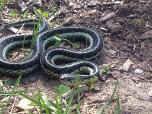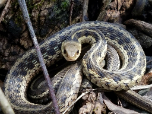Chicago Garter Snake (Thamnophis sirtalis semifasciatus)
Description: The Illinois Natural History Survey describes the Chicago garter snake as a medium-sized, up to 39 inches in total length, including the tail), dark brown or black snake with a yellow or gray mid-back stripe, a yellow stripe on each side, and a gray-green belly with dark spots on the edges of most of the belly scales. The snake's head is usually without parietal light spots. Some specimens have red coloring between the side scales.
One feature that distinguishes the Chicago garter snake from other garter snake subspecies, especially the eastern garter snake (Thamnophis sirtalis sirtalis), is, in Thamnophis sirtalis semifasciatus, the snake's side stripe is broken, near the snake's head, into a dashed line by black crossbars.
Habitat: The snake prefers forest and edge habitats near a body of water. It is a cold-tolerant snake that occasionally emerges from hibernation to bask on warm winter days.
Range: Native to the Chicago, United States, region. It can be found in the vicinity of rural waterways in northeastern Illinois, such as Piscasaw Creek in Boone County and McHenry County, Illinois.
Found in these States:
IL |
IN |
WI
Diet: Its diet includes fish, amphibians, young birds, and invertebrates such as earthworms, slugs, and snails.
Reproduction: The females, like other garter snakes, give birth to a clutch of 15 to 80 live young; parturition is typically in July through early October. The newborn snakes are 6 to 8 inches in total length.
Status: Listed as Least Concern in view of its extremely wide distribution, presumed large population, and because populations are unlikely to be declining.
»» Kingdom: Animalia - Animals
»» Phylum: Chordata - Chordates
»» Subphylum: Vertebrata - Vertebrates
»» Class: Reptilia - Reptiles
»» Order: Squamata - Scaled Reptiles
»» Suborder: Serpentes
»» Superfamily: Colubroidea
»» Family: Colubridae - Colubrids
»» Genus: Thamnophis
»» Species: Thamnophis sirtalis - Common Garter Snakes
»» Subspecies: Thamnophis sirtalis semifasciatus - Chicago Garter Snake
This article uses material from the Wikipedia article "Thamnophis sirtalis semifasciatus", which is released under the Creative Commons Attribution-Share-Alike License 3.0. Content may have been omitted from the original, but no content has been changed or extended.
|













